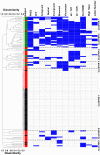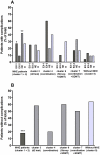The PHES battery does not detect all cirrhotic patients with early neurological deficits, which are different in different patients
- PMID: 28146589
- PMCID: PMC5287470
- DOI: 10.1371/journal.pone.0171211
The PHES battery does not detect all cirrhotic patients with early neurological deficits, which are different in different patients
Abstract
Background and aims: The psychometric hepatic encephalopathy score (PHES) is the "gold standard" for minimal hepatic encephalopathy (MHE) diagnosis. Some reports suggest that some cirrhotic patients "without" MHE according to PHES show neurological deficits and other reports that neurological alterations are not homogeneous in all cirrhotic patients. This work aimed to assess whether: 1) a relevant proportion of cirrhotic patients show neurological deficits not detected by PHES; 2) cirrhotic patients with mild neurological deficits are a homogeneous population or may be classified in sub-groups according to specific deficits.
Methods: Cirrhotic patients "without" (n = 56) or "with" MHE (n = 41) according to PHES and controls (n = 52) performed psychometric tests assessing attention, concentration, mental processing speed, working memory and bimanual and visuomotor coordination. Heterogeneity of neurological alterations was analysed using Hierarchical Clustering Analysis.
Results: PHES classified as "with" MHE 42% of patients. Around 40% of patients "without" MHE according to PHES fail two psychometric tests. Oral SDMT, d2, bimanual and visuo-motor coordination tests are failed by 54, 51, 51 and 43% of patients, respectively. The earliest neurological alterations are different for different patients. Hierarchical clustering analysis shows that patients "without" MHE according to PHES may be classified in clusters according to the tests failed. In some patients coordination impairment appear before cognitive impairment while in others concentration and attention deficits appear before.
Conclusions: PHES is not sensitive enough to detect early neurological alterations in a relevant proportion of cirrhotic patients. Oral SDMT, d2 and bimanual and visuo-motor coordination tests are more sensitive. The earliest neurological alterations are different in different cirrhotic patients. These data also have relevant clinical implications. Patients classified as "without MHE" by PHES belonging to clusters 3 and 4 in our study have a high risk of suffering clinical complications, including overt HE and must be diagnosed and clinically followed.
Conflict of interest statement
The authors have declared that no competing interests exist.
Figures





Similar articles
-
Non invasive blood flow measurement in cerebellum detects minimal hepatic encephalopathy earlier than psychometric tests.World J Gastroenterol. 2014 Sep 7;20(33):11815-25. doi: 10.3748/wjg.v20.i33.11815. World J Gastroenterol. 2014. PMID: 25206287 Free PMC article.
-
Altered postural control and stability in cirrhotic patients with minimal hepatic encephalopathy correlate with cognitive deficits.Liver Int. 2017 Jul;37(7):1013-1022. doi: 10.1111/liv.13345. Epub 2017 Feb 3. Liver Int. 2017. PMID: 27988985
-
Serum nitrotyrosine and psychometric tests as indicators of impaired fitness to drive in cirrhotic patients with minimal hepatic encephalopathy.Liver Int. 2013 Nov;33(10):1478-89. doi: 10.1111/liv.12206. Epub 2013 May 29. Liver Int. 2013. PMID: 23714168
-
Diagnosis and Treatment of Low-Grade Hepatic Encephalopathy.Dig Dis. 2015;33(4):562-9. doi: 10.1159/000375350. Epub 2015 Jul 6. Dig Dis. 2015. PMID: 26159274 Review.
-
Sarcopenia and cognitive impairment in liver cirrhosis: A viewpoint on the clinical impact of minimal hepatic encephalopathy.World J Gastroenterol. 2019 Sep 21;25(35):5257-5265. doi: 10.3748/wjg.v25.i35.5257. World J Gastroenterol. 2019. PMID: 31558871 Free PMC article. Review.
Cited by
-
Enhanced BDNF and TrkB Activation Enhance GABA Neurotransmission in Cerebellum in Hyperammonemia.Int J Mol Sci. 2022 Oct 4;23(19):11770. doi: 10.3390/ijms231911770. Int J Mol Sci. 2022. PMID: 36233065 Free PMC article.
-
Learning and Memory Impairments in Patients with Minimal Hepatic Encephalopathy are Associated with Structural and Functional Connectivity Alterations in Hippocampus.Sci Rep. 2018 Jun 25;8(1):9664. doi: 10.1038/s41598-018-27978-x. Sci Rep. 2018. PMID: 29941971 Free PMC article.
-
Abnormal Regional Homogeneity and Functional Connectivity of Baseline Brain Activity in Hepatitis B Virus-Related Cirrhosis With and Without Minimal Hepatic Encephalopathy.Front Hum Neurosci. 2018 Jun 22;12:245. doi: 10.3389/fnhum.2018.00245. eCollection 2018. Front Hum Neurosci. 2018. PMID: 29988437 Free PMC article.
-
Minimal hepatic encephalopathy is associated to alterations in eye movements.Sci Rep. 2022 Oct 7;12(1):16837. doi: 10.1038/s41598-022-21230-3. Sci Rep. 2022. PMID: 36207472 Free PMC article.
-
Role of peripheral inflammation in minimal hepatic encephalopathy.Metab Brain Dis. 2024 Dec;39(8):1667-1677. doi: 10.1007/s11011-024-01417-5. Epub 2024 Aug 23. Metab Brain Dis. 2024. PMID: 39177864 Review.
References
-
- Ferenci P, Lockwood A, Mullen K, Tarter R, Weissenborn K, Blei AT. Hepatic encephalopathy. Definition, nomenclature, diagnosis and quantification: final report of the working party at the 11th World Congress of Gastroenterology, Vienna, 1998. Hepatology. 2002;35:716–721. 10.1053/jhep.2002.31250 - DOI - PubMed
-
- Amodio P, Montagnese S, Gatta A, Morgan MY. Characteristics of minimal hepatic encephalopathy. Metab Brain Dis. 2004;19:253–267. - PubMed
-
- Montoliu C, Piedrafita B, Serra MA, del Olmo JA, Ferrandez A, Rodrigo JM, et al. Activation of soluble guanylate cyclase by nitric oxide in lymphocytes correlates with minimal hepatic encephalopathy in cirrhotic patients. J Mol Med. 2007;85:233–241. - PubMed
MeSH terms
LinkOut - more resources
Full Text Sources
Other Literature Sources

